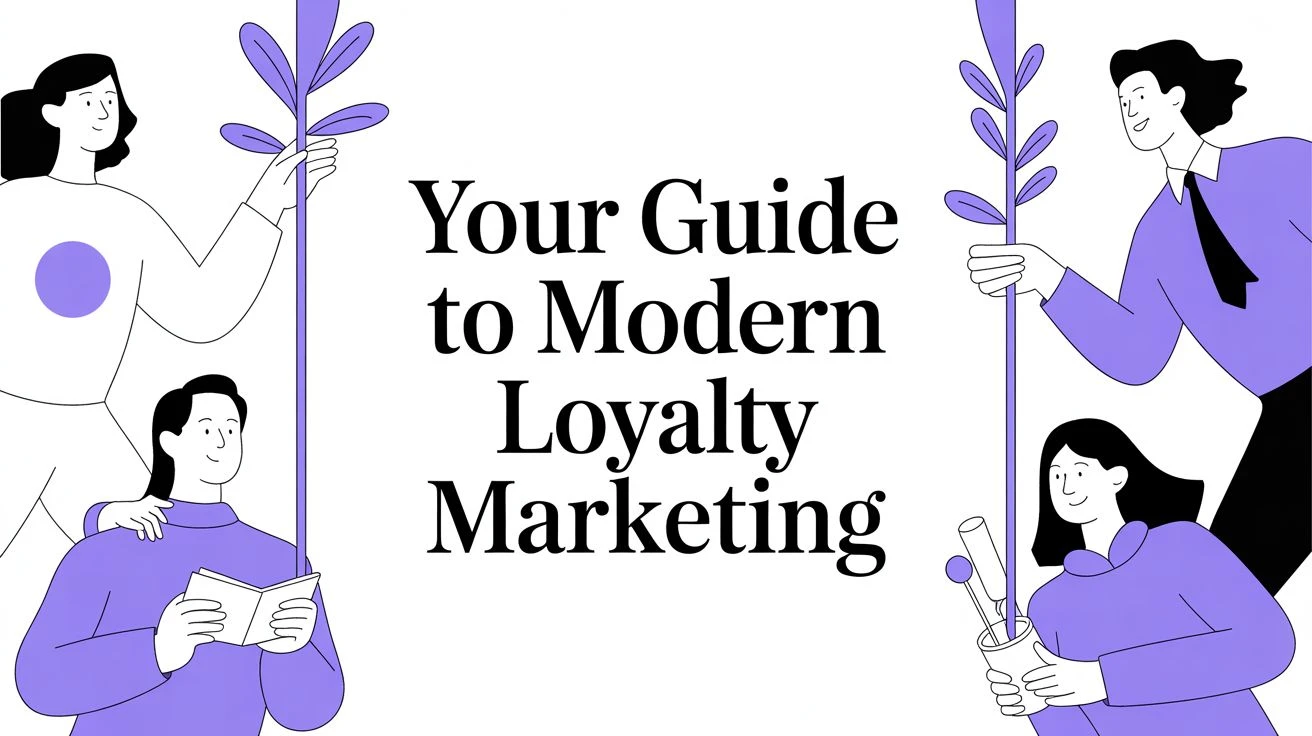Loyalty marketing isn't about chasing the next sale. It’s a smarter way to grow your business by focusing on the people who already know and love you: your existing customers. Instead of pouring all your energy into finding new buyers, you build real, long-term relationships with your current ones through rewards, personalized experiences, and genuine appreciation.
The goal? To turn one-time shoppers into repeat customers, and repeat customers into loyal fans who stick with you through thick and thin.
The Shift From Transactions To Relationships
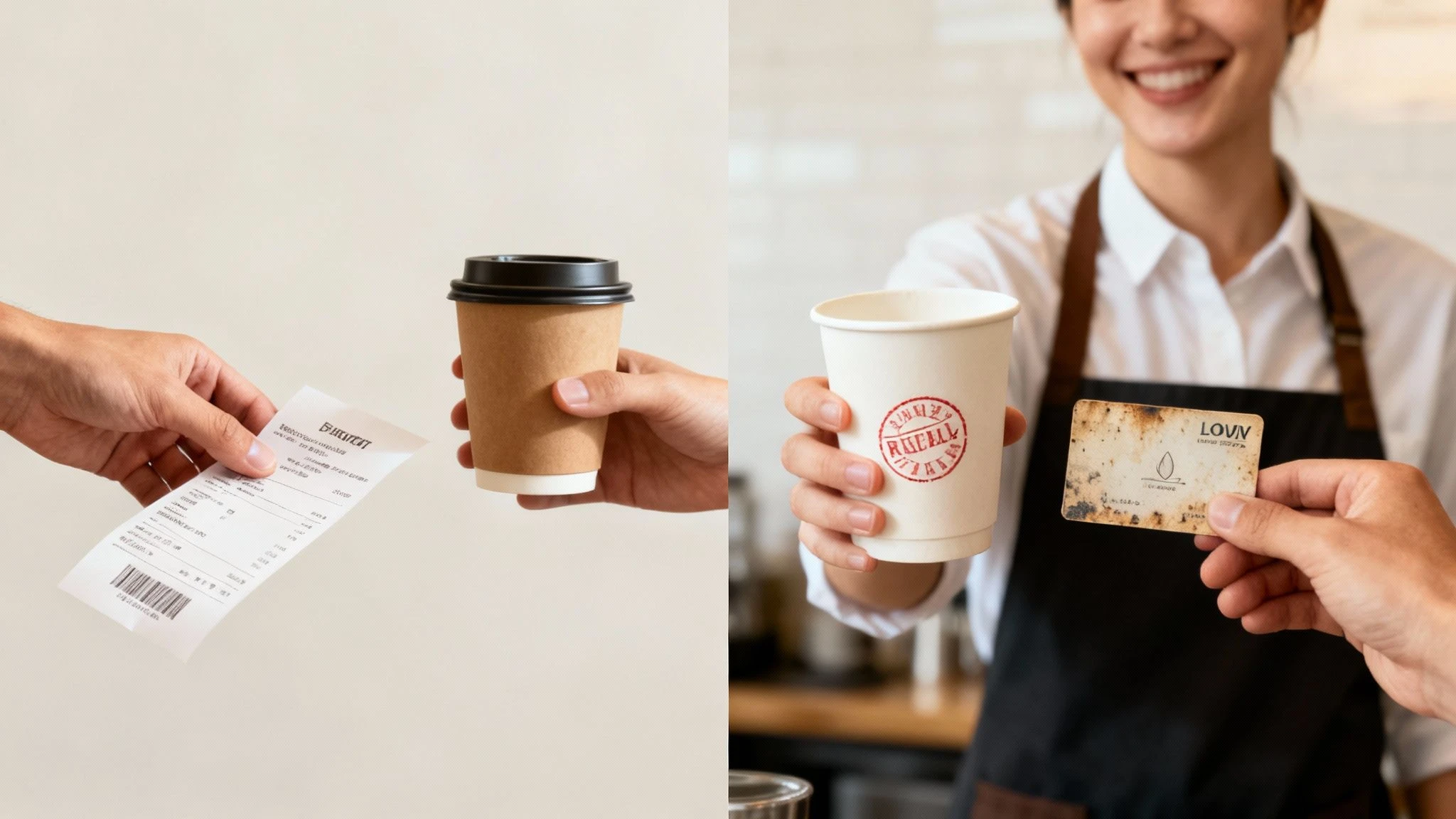
Think of it like this: acquiring a new customer is like a first date. It’s exciting, and you’re focused on making a great first impression. Loyalty marketing, on the other hand, is like building a lasting friendship. It’s about nurturing that connection long after the initial introduction, making sure your customers feel seen and valued every time they interact with you.
This isn’t just a feel-good idea; it’s a rock-solid business strategy. The numbers don't lie: it can cost five times more to attract a new customer than to keep an existing one. Focusing on loyalty is just smart economics. You’re moving away from one-off sales and building a stable, predictable foundation for growth.
To get a better sense of how this works in practice, let's compare it to the traditional marketing playbook most of us are familiar with.
Loyalty Marketing vs Traditional Marketing
This table breaks down the core differences in how each approach thinks about customers, goals, and success.
| Aspect | Traditional Marketing (Acquisition) | Loyalty Marketing (Retention) |
|---|---|---|
| Primary Goal | Attract as many new customers as possible. | Keep existing customers happy and coming back. |
| Focus | The "top of the funnel"-awareness and first purchase. | The entire customer journey, especially post-purchase. |
| Key Metrics | Leads, conversion rates, cost per acquisition (CPA). | Customer lifetime value (CLV), repeat purchase rate, churn rate. |
| Mindset | Transactional: "How do we make the next sale?" | Relational: "How do we build a lasting connection?" |
| Communication | Broad, one-to-many messaging (ads, campaigns). | Personalized, one-to-one communication (rewards, targeted offers). |
As you can see, loyalty marketing is a fundamental shift. It’s about farming, not just hunting.
Why Does This Matter So Much Right Now?
Focusing on loyalty has never been more critical. Advertising costs are climbing, and competition is everywhere. Businesses simply can't afford to rely on a constant stream of new buyers anymore. The real, sustainable growth comes from the customers who already trust you.
Understanding the power of improving customer retention is the first step. By nurturing this audience, you create a community of advocates who not only keep buying but also spread the word for you. The heart of this strategy is often a formal loyalty program, which gives customers a clear reason to stick around.
A great loyalty marketing strategy creates a "flywheel" effect. Happy customers lead to repeat business, which leads to positive reviews and word-of-mouth referrals. Those referrals then bring in new customers for a fraction of the usual cost.
The Numbers Behind The Loyalty Boom
This isn't just a trend; it's a massive market shift. The global loyalty management market is on track to explode, growing from $13.31 billion in 2024 to an estimated $41.21 billion by 2032.
Why the surge? Because brands are realizing that retention is where the real money is. A whopping 83% of businesses with loyalty programs report a positive return on their investment. On average, these programs generate 5.2 times more revenue than they cost to run.
At the end of the day, loyalty marketing helps you build a more resilient business. You create a core group of customers who are less sensitive to price changes and more forgiving when things go wrong. They stick with you because you offer them value that goes far beyond the product itself.
The Evolving Nature of Customer Loyalty
Think of customer loyalty less like a trophy you win once and more like a garden. If you stop tending to it, it withers. That's the new reality of loyalty marketing-it’s a living, breathing relationship that has to be earned over and over again with every single interaction.
The old-school idea that a customer is "locked in" after a few purchases just doesn't hold up anymore. Today, loyalty is fluid. It's influenced by everything from price and convenience to whether your brand's values click with theirs. Someone might love your coffee today but jump to a competitor tomorrow if they’re offering a better deal.
The Challenge of Modern Loyalty
The ground is shifting beneath our feet. Consumer loyalty is more fragile than it has been in years. In fact, true, deep-seated loyalty is projected to drop for the first time in five years, from 34% in 2024 to 29% in 2025. This shows just how fast customers are willing to shop around in a market flooded with options.
But here’s the good news: 68% of consumers still say they feel loyal to certain brands. This tells us that while the bar for earning that loyalty is much higher, it’s not impossible. The real takeaway is that brands have zero room for error. A staggering 77% of consumers now pull back their loyalty faster than they did just three years ago, and 61% switched some or all of their business from one brand to another in the last year. You can dive deeper into these customer loyalty statistics to get the full picture.
This shift puts a huge spotlight on the need for smart retention strategies. Brands can't just coast on habit anymore; they have to actively give customers a great reason to stay.
Engaging the Silently Loyal Customer
Most small businesses have a secret weapon they don't even know they have: the "silently loyal" customer. These are your regulars-the people who grab a coffee every morning or stop by your shop a few times a year. They like you, but they aren't signed up for anything. Their loyalty is more of a habit than a conscious choice.
This group is a massive, untapped opportunity. They already have a positive association with your business, but their loyalty is passive. It's vulnerable. A new competitor opening up down the street could easily lure them away.
This is where modern loyalty marketing comes in. The goal is to turn that quiet appreciation into an active, engaged relationship. It’s about giving them a reason to choose you, consciously, every single time. And you can do it with simple, easy-to-use programs that don’t involve another plastic card or a bunch of confusing rules.
The best loyalty programs don't just reward transactions; they acknowledge the customer's choice to come back. They make people feel seen and valued, turning a passive habit into an active preference.
Why Loyalty Falters and How to Fix It
So, what makes a once-loyal customer stray? It usually boils down to two things: price and options. When money is tight, a better price somewhere else is a powerful pull. And when there are a dozen alternatives just a click away, the effort it takes to switch is practically zero.
To fight this, your loyalty strategy has to offer value that goes beyond the price tag. This is where you get creative with personalized rewards, exclusive access, or a sense of community. It’s not about just offering 10% off; it's about making your customer feel like an insider.
Your loyalty marketing should be built on these simple ideas:
- Acknowledge Their Choice: Make it obvious you see them and appreciate their business.
- Offer Real Value: Give them rewards that are easy to understand and genuinely useful.
- Build an Emotional Connection: Create small moments that make them feel like part of your story.
At the end of the day, loyalty is earned in moments. Every smooth checkout, every friendly conversation, and every thoughtful reward is a deposit in the customer relationship bank. The trick is to just keep making those deposits, consistently and genuinely.
Core Strategies for Building a Loyalty Program
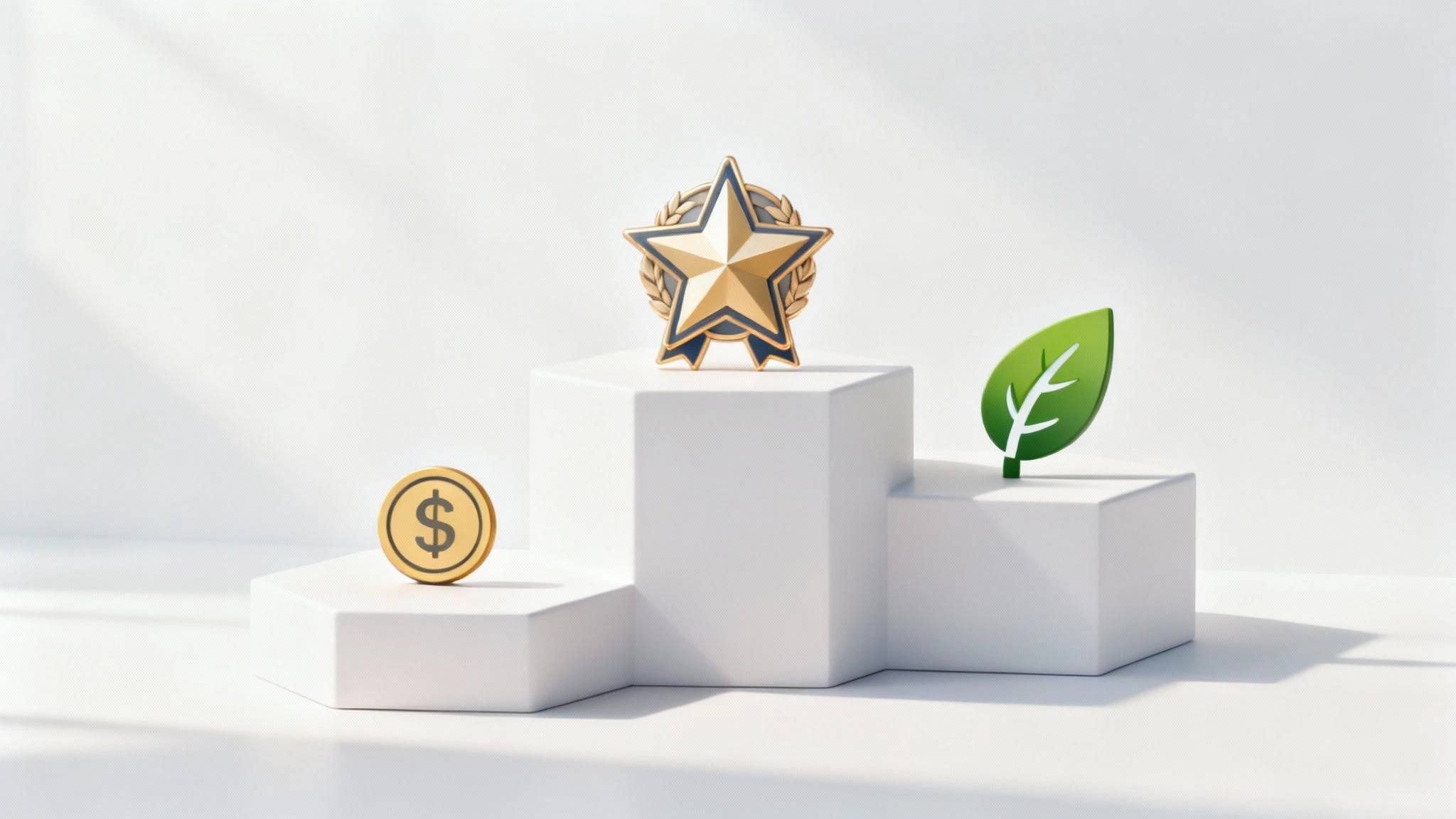
Alright, so you get why loyalty is a big deal. Now for the fun part: the how. Building a loyalty program that actually works isn't about some secret formula. It’s about picking the right game plan for your business and your customers.
The best programs feel simple, generous, and make people feel smart for sticking with you. At the end of the day, a loyalty program is just a structured way to say "thanks" to the folks who keep your doors open. Let's dig into the most effective ways to do it.
The Classic Points-Based System
The points-based model is the OG for a reason: it just makes sense. Customers earn points for every dollar they spend, then cash those points in for rewards. Think of it as a digital punch card that never gets lost in a wallet.
A local coffee shop, for instance, might give out 10 points for every dollar. Once a customer hits 1,000 points, they get a free specialty latte. This is perfect for businesses with frequent, smaller sales because people see their points stack up fast. That quick feedback loop feels good and keeps them coming back.
The real magic here is clarity. There's no confusing math for the customer, just a simple "earn and burn" cycle that feels rewarding. For a deeper dive, our guide on setting up a successful loyalty program with points walks you through the nuts and bolts.
The Aspirational Tiered Program
Tiered programs add a bit of gamification to the mix. Customers don’t just earn points; they climb ranks, unlocking better perks and a higher status along the way. This taps right into our natural desire for achievement and a little bit of exclusivity.
Starbucks Rewards is the master of this. Customers move up from a basic green level to "Gold," unlocking cool extras like free refills and members-only offers. Each new tier feels like you've accomplished something, which is a brilliant way to get people to visit more often or add that extra pastry to their order. They’re not just buying coffee-they’re on a mission.
This model is a home run for brands that want to build a real community and make their top customers feel like total VIPs.
Tiered programs transform customer loyalty from a simple transaction into a journey. The desire to reach the next level keeps customers engaged and motivated, creating a powerful emotional connection to the brand.
The Values-Driven Program
This is where you connect with customers on a whole other level. Instead of just rewarding what they buy, you reward actions that align with what you both believe in. This kind of loyalty marketing forges a powerful sense of community that discounts can’t buy.
The outdoor brand Patagonia nails this. Their program isn't about buying more; it's about sustainability. They reward customers for trading in old gear or repairing items instead of tossing them. This doesn't just sell jackets; it reinforces the brand's core mission and attracts people who share that same environmental mindset.
This strategy shines when your brand stands for something more than just profit. It turns customers into true fans who are loyal because they believe in what you’re doing.
Choosing Your Loyalty Program Model
So, which one is right for you? It really boils down to your business, your customers, and your brand's personality. A model that works wonders for a bustling cafe might fall flat for a high-end boutique.
To help you figure it out, let's break down the options side-by-side.
| Program Model | How It Works | Best For | Key Benefit |
|---|---|---|---|
| Points-Based | Customers earn points for purchases, which are redeemed for rewards. | Businesses with frequent, low-to-mid value transactions (e.g., cafes, QSR). | Simplicity and fast gratification. Customers easily understand how to earn and redeem. |
| Tiered | Customers unlock higher levels of status and better perks with increased spending. | Brands with a strong community aspect or aspirational products (e.g., airlines, cosmetics). | Fosters long-term engagement by creating a sense of achievement and exclusivity. |
| Value-Based | Customers are rewarded for actions that align with the brand's mission (e.g., recycling, donating). | Mission-driven brands with a strong ethical or community focus. | Builds deep emotional loyalty by connecting with customers over shared beliefs. |
Ultimately, the goal is to create a program that feels like a natural part of your brand, not a clunky add-on. Don't be afraid to mix and match elements to create something that’s uniquely yours.
For more ideas on keeping people hooked, check out these 10 High Impact Customer Retention Strategies. The real key is to deliver consistent value that makes your customers feel seen, appreciated, and excited to come back.
What's Next for Loyalty Marketing?
The old-school punch card had a good run, but let's be honest-its days are numbered. The future of loyalty marketing is looking a whole lot smarter and more personal. Today's customers don’t just want a simple discount for showing up; they want to feel seen, understood, and valued. The game is no longer about transactions, but about building real, emotional connections.
To stand out, businesses have to move past the classic "buy ten, get one free" formula. It's time to use data to understand what makes your customers tick and create interactions that feel like they were made just for them. It’s all about making every single customer feel like they’re your only customer.
It’s About to Get Personal-Hyper-Personal
Imagine a loyalty program that knows you so well it pings you with a reward for your favorite pastry on a random Tuesday, just because. That's the magic of hyper-personalization. Instead of blasting out the same generic offer to everyone, forward-thinking brands are digging into customer data to send the right reward, to the right person, at the perfect moment.
This goes way beyond just using a customer's first name and looking at their last purchase. Modern loyalty marketing factors in browsing habits, how often someone visits, and even the time of day they usually shop. The result is a program that feels less like a sales pitch and more like a helpful friend who just gets you.
Making Loyalty Fun with Gamification
Why do we get such a kick out of earning badges or leveling up in a game? It’s simple: we're wired to love progress and achievement. Gamification takes these same psychological triggers and applies them to loyalty marketing, turning what could be a chore into something genuinely fun.
Instead of just passively collecting points, customers can get in on the action:
- Take on Challenges: "Try our new cold brew this week and get 50 bonus points!"
- Earn Bragging Rights: Award cool digital badges for milestones like "Weekly Regular" or "Coffee Connoisseur."
- Unlock Secret Achievements: Create a sense of discovery by rewarding customers for exploring different parts of your menu or store.
This whole approach cranks up engagement by making your program feel alive and interactive. It gives people more reasons to connect with your brand than just the next transaction.
It’s Not About Discounts, It’s About Experiences
Everyone loves a good deal, but the rewards that really stick are the ones you can't put a price on. A 10% discount is nice, but it’s forgotten by tomorrow. An exclusive experience? That creates an emotional high-five with your brand that a competitor can’t just copy.
The future of loyalty isn't just about saving a few bucks; it's about feeling like you're part of an exclusive club. Special access, unique events, and one-of-a-kind experiences forge much stronger bonds than a simple discount ever could.
So instead of just another freebie, think bigger. What about rewards like:
- A VIP tasting event at your restaurant.
- An invitation to a members-only, first-dibs sale.
- A free workshop or class that ties into what you do.
These are the kinds of perks that provide real value beyond money and make your best customers feel like true insiders.
The data backs this up. A whopping 58% of brands are making personalization their top investment priority for 2025. On top of that, over 45% of brands see gamification and experience-based rewards as the next big thing. And with 60% of businesses now laser-focused on Customer Lifetime Value (CLV) as their main metric for success, the message is loud and clear. You can dig into more of these emerging loyalty program trends yourself. The takeaway? Creating fun, personal, and memorable interactions isn't just a good idea anymore-it's the only way to build loyalty that lasts.
Loyalty Marketing for Small Businesses
For a lot of small business owners, the idea of launching a loyalty program can feel… big. It brings to mind expensive software, clunky point-tracking systems, and a learning curve you just don't have time for. But here’s the good news: those days are over.
Modern tools have totally changed the game, making loyalty programs practical and affordable for everyone, not just the corporate giants. You no longer need a dedicated IT team or a huge budget to start rewarding your regulars. The focus has shifted from complicated tech to simple, effective solutions that both you and your customers will actually enjoy using.
It’s about finding a tool that works for you, not against you. A solution that’s quick to set up and easy to manage can turn loyalty marketing from a headache into one of your best growth strategies.
Making Loyalty Simple and Effective
Let's imagine a local coffee shop, "The Daily Grind." The owner, Sarah, knows her regulars by name, but she doesn't have an easy way to thank them for their business. She wants a loyalty program but dreads the thought of buying clunky hardware or forcing customers to download yet another app they’ll forget about.
This is exactly where a tool like BonusQR comes in. It was designed from the ground up for small businesses like Sarah's, knocking down all the usual barriers. There’s no complex software to install and zero expensive equipment to buy. It all runs through a simple QR code that customers scan with their phones. Easy.
The screenshot below shows just how clean and straightforward the BonusQR interface is, for both the business owner and the customer.
This user-friendly design means Sarah can get her program up and running in minutes, creating a smooth experience for her customers right out of the gate.
For a small business, the best loyalty program is one that actually gets used. Simplicity isn't a compromise; it's the feature that drives participation and delivers real results without adding more to your plate.
With a QR-based system, Sarah can start gathering useful customer insights without lifting a finger. She can see who her most frequent visitors are, track which days are busiest, and understand what people are buying-all without manual data entry. For a small business owner, that information is gold.
From Data to Deeper Connections
Armed with this new data, Sarah can take her marketing to the next level. She might notice a group of customers who stop in every single weekday morning. Using a tool like BonusQR, she can send just that group a targeted offer, like, "Enjoy a free pastry with your coffee this Friday!"
That small, personal gesture does more than just drive another sale. It makes those customers feel seen and appreciated, which strengthens their bond with The Daily Grind. It’s a powerful way to turn casual visitors into true advocates for her business. For a deeper dive into this, our guide on maximizing customer retention with a small business loyalty program breaks down the practical steps.
This is how small businesses build a strong, local community of fans who feel a real connection to the brand. It’s not just about transactions; it’s about creating a place where people feel they belong. By using simple, smart tools, any small business can compete with the big guys, building loyalty one customer at a time.
Building Your Customer Loyalty Flywheel
Forget thinking about loyalty marketing as a straight line with a start and finish. A much better way to look at it is as a powerful, self-sustaining engine for your business-a customer loyalty flywheel. This isn't about one-off rewards; it's a continuous cycle that picks up speed and power the more you use it.
The whole point of this approach is to do more than just keep customers around. It’s about turning them into an active part of your growth. Each stage of the flywheel feeds the next, creating a loop where happy customers naturally bring new ones through your door.
Let’s break down the four stages that get this engine humming.
Engage: Provide Ongoing Value
The flywheel kicks off with engagement. This is where you give customers consistent value that keeps the conversation going long after they’ve made a purchase. It’s about keeping your brand top-of-mind without constantly pushing for a sale.
This could be as simple as sending a personalized offer, sharing something useful, or just acknowledging a recent visit. It's about building a real relationship. There's a reason for this: research shows loyalty program members drive 12% to 18% more revenue growth each year than non-members, mostly because they stay consistently connected to the brand.
Reward: Offer Tangible Benefits
Once a customer is engaged, the reward stage gives them a solid reason to come back. This is the heart of any good loyalty program-giving people real benefits that make them feel appreciated and smart for sticking with you. Your rewards don't need to be complicated, but they absolutely need to be valuable and easy to grasp.
This infographic shows just how seamless the reward process can be with a simple tool like BonusQR.
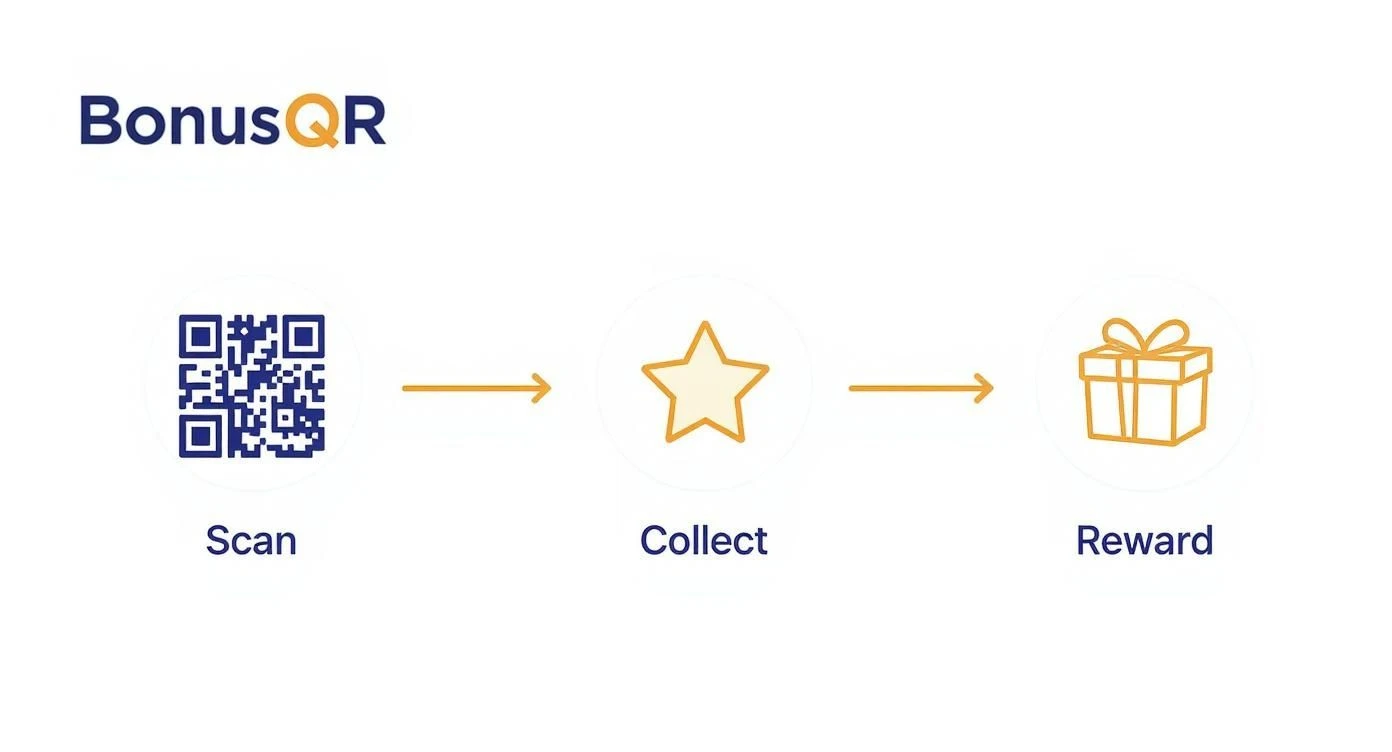
The big takeaway here is simplicity. When the process is painless, customers actually use the program and feel the immediate win of being loyal. That feeling is what pushes them into the next stage.
Advocate: Turn Customers into Fans
This is where the real magic happens. When people feel seen, heard, and rewarded, their loyalty deepens. They stop being just another customer and start becoming genuine fans who are excited about what you do.
These brand ambassadors start talking. They share their great experiences with friends, family, and their followers online. This kind of word-of-mouth is incredibly powerful because it’s coming from a trusted source, not a paid ad.
The ultimate goal of loyalty marketing is to create a customer who does your marketing for you. Their authentic endorsement is more persuasive than any campaign you could create.
Grow: Attract New Customers
The final stage, Grow, closes the loop. All the positive buzz from your advocates directly fuels new customer growth. Think about it: when a friend raves about a local cafe because of its great rewards program, that recommendation carries a ton of weight.
This kind of organic growth is incredibly efficient, meaning you can rely less on expensive advertising. Best of all, every new customer brought in by a fan enters the flywheel right at the Engage stage. The whole cycle starts over, gaining more and more momentum with every turn. When you adopt this mindset, you start building your own growth engine, one loyal customer at a time.
Frequently Asked Questions About Loyalty Marketing
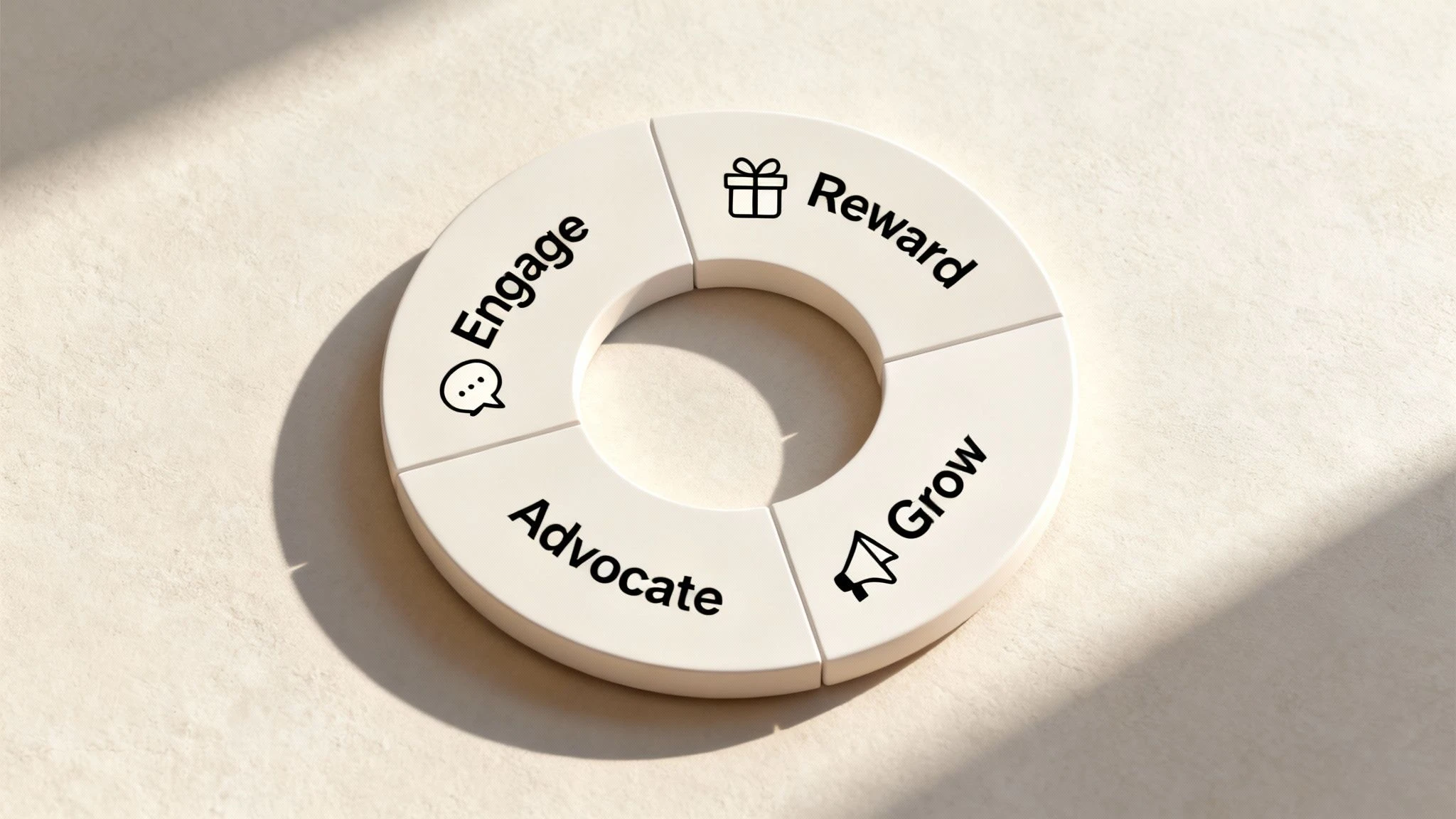
Even with the best game plan, a few questions are bound to pop up as you get started. Here are some of the most common ones we hear, with straightforward answers to help you launch your loyalty program with confidence.
How Much Does a Loyalty Marketing Program Cost?
This is the big one, and the honest answer is: it really depends. Custom-built programs for huge corporations can easily run into the tens of thousands of dollars. But for small businesses, the game has completely changed.
Modern digital tools are designed to be incredibly affordable, often running on a low monthly subscription. Solutions like BonusQR are built specifically to get rid of high upfront costs and the need for clunky hardware. This puts a powerful loyalty program within reach for any budget, from a solo coffee cart to a busy salon.
What Is the Most Important Metric to Track?
While it's smart to watch things like repeat purchase rates and how often rewards get redeemed, the one metric that tells the real story is Customer Lifetime Value (CLV). In simple terms, CLV tells you how much money a customer is likely to spend with you over their entire relationship with your business.
A great loyalty program gives CLV a direct boost. It keeps customers coming back more often and makes it less likely they'll stray to a competitor. When your CLV is on the rise, it's the clearest sign that your loyalty efforts are paying off in a big way.
Tracking CLV shifts your focus from short-term sales to long-term profitability. It helps you understand the true financial impact of building strong customer relationships, proving that loyalty is one of your most valuable assets.
Can Loyalty Marketing Work for a Service Business?
Absolutely. Loyalty marketing isn't just for businesses selling coffee or t-shirts. At its heart, it’s about rewarding people for their repeat business and showing you appreciate them-a perfect fit for any service-based company.
Instead of rewarding a product purchase, you just reward a valuable action. For example:
- Salons and Spas: Offer a nice discount after a client books their fifth haircut or massage.
- Consultants or Coaches: Provide exclusive content or a free 30-minute session for client referrals.
- Auto Repair Shops: Give a small reward to customers who pre-book their next oil change or refer a new driver.
The trick is to identify the actions that really drive your business forward and build your rewards around them. It’s all about encouraging the habits that lead to steady growth and a rock-solid client base.
Ready to turn your customers into loyal fans without the complexity or high cost? BonusQR makes it easy to launch a digital loyalty program in minutes. Start building your customer loyalty flywheel today with BonusQR.
